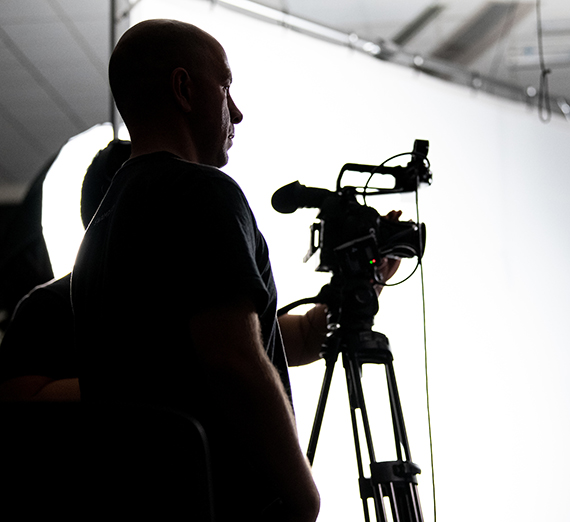Gonzaga's IDD Team Fosters Community in Remote Learning

How do you best maintain Gonzaga’s academic style and its unique, tight-knit sense of community within remote learning environments?
It’s easy for the instructional design and delivery (IDD) team. After all, Director Justin Marquis, Ph.D., is also a faculty member and most of his team of virtual learning experts are graduates from Gonzaga undergraduate and graduate programs. They showcase that first-hand experience by designing online courses for all students to experience.
When this agile team recently needed to pivot Gonzaga quickly to a fully virtual undergraduate teaching environment due to COVID-19, they were prepared. Online or remote course delivery had been in place since 1998.
Marquis believes in the value of a Gonzaga education, and is passionate about making it available to all students across all platforms offered by the University.
“People in the office understand 100 percent what a Gonzaga undergraduate experience is – and know what it should be. The focus has always been on how do we give the students the same level of engagement and experience in learning that they would get if they were on campus,” he says.
Marquis admits there are inherent differences in the two learning environments, but stresses that everybody – including faculty and staff are striving for excellence as the goal of their work.
“There is a fundamental difference between face-to-face and online – everybody gets that,” said Marquis. “I think that, while the learning experience is different, one doesn’t need to be less than the other. The online environment levels the playing field in a lot of ways.”
Marquis points out that participation can sometimes be limited in a face-to-face setting, based on sociological factors. As an example, a student who isn’t inclined to immediately answer a question on the spot may be reticent to answer in a real-time, in-person classroom setting.
Creative Solutions Students Enjoy
Bunji McLeod (’20), now a graduate with a degree in mechanical engineering and experience from the Hogan Entrepreneurial Leadership Program, shares the way his faculty members adapted when senior projects are normally very hands-on and team oriented. They “rolled with the punches,” he said, “using a lot of digital software for modeling and predictions and equations, using 3-D models for the main part of our presentation.”
While he admits it’s not possible to replicate working with physical prototypes with real equipment in a machine shop, faculty members like Derek Larson offered a different type of value. He shifted his focus to being a valuable resource for networking on engineering jobs, offering students feedback on their resumes and applications.
The learning systems leveraged by Gonzaga provide interactive tools such as discussion boards and posts, which can foster broader, meaningful participation to all students when facilitated by faculty members.
McLeod attests to that. “Professors want the best for us, best care of the whole person,” he says. As an example, Professor Brian Steverson hosted informal chats where students chose the topics. “Students were really engaged – everyone had their cameras on for this. It was really fun,” McLeod shares.
How about the students in the performing arts, unable to be on stage together or rehearse music in settings with appropriate acoustics?
Choir student and education major Bel Thurston (’21) says Timothy Westerhaus, chair of the music department went “above and beyond not just to make our music progress, but to keep us connected as people. He has made this online experience much more interactive and engaging than it could have been.”
Westerhaus used Kahoot quizzes to help students learn more about each other, and announced his decision on the fall musical (“Pirates of Penzance”) by arriving to the Zoom class dressed in full pirate attire.
“There’s no substitute for being together, live, but we came together still,” says Thurston.
Adaptive and Thoughtful
“We’re seeing now that almost every student is being given time to reflect and compose their thoughts and think deeply about things,” says Marquis. “All the students can take time to process things and reflect, in a very Ignatian way, on what the questions asked mean to them and to the broader world around them to give deeper, more thoughtful answers.”
He says the challenge of adapting undergraduate classes to online-only has transformed into an opportunity to further elevate teaching with a set of new tools that weren’t always available.
The move to a remote environment for undergraduate classes has been an accelerant for students and faculty to keep looking beyond the four walls of a classroom. GU’s technology platform allows for multiple ways to easily incorporate digital resources, including multimedia and visually-based content that has been proven more effective for some learning styles.
When classes can more seamlessly integrate virtual resources into daily teaching, connections with worldwide resources and experts are more accessible. This spring, one class of undergraduate students interacted with Nobel Prize-winning economist Paul Krugman via Zoom. Other classes have participated in virtual tours of world-class libraries, art museums and ancient archaeological sites.
The value of a degree from the university translates across learning delivery platforms, based in large part on the institution’s culture of attracting top-tier students and faculty members.
“As a student, you end up with peers who push you more,” says Marquis. “So, the level of discussion and the level of engagement is higher. Also, the level of connectivity (with classmates and faculty) is much richer here, which can be even better when connecting online.”
The connections are different, but no less meaningful. The Gonzaga experience is universal.
